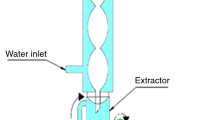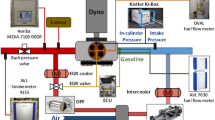Abstract
Blended fuels have intrinsic potential for substitution with petro fuel for the purpose of emission control and fuel efficiency improvement. Therefore, in the current study, non-reacting spray characteristics of heavy fuel oil (HFO) combined with microalgal biodiesel as blended fuel under ultra-high injection pressure is numerically investigated. To accomplish this task with spray morphology, the characteristics of spray penetration, spray cone angle, spray volume and Sauter Mean Diameter (SMD) are studied. The OpenFOAM CFD toolbox is employed with Eulerian–Lagrangian multiphase formulation for fuel discrete phase interacting with gaseous continuous phase modeling. Lagrangian particle tracking (LPT) method is applied for the fuel droplet tracking by Lagrangian scheme. Moreover, hybrid breakup model of KH-RT and k − ϵ as the standard model in Reynolds Averaged Navier–Stokes (RANS) are used for liquid fuel core breakup and turbulence modeling, respectively. Computational results are validated against existing experimental data for HFO and good agreements are displayed. Longer spray penetration length with sharper tip, wider spray cone angle, more obese spray volume and lower SMD are obtained for the blended fuels. Overall, it is concluded that HFO-microalgal biodiesel blended fuels present a better fuel–air mixture and improves atomization procedure under high and ultra high injection pressures.



























Similar content being viewed by others
Abbreviations
- HFO:
-
Heavy fuel oil
- PM:
-
Particulate matter
- RANS:
-
Reynolds averaged Navier–Stokes
- RMSE:
-
Root mean square error
- ASOI:
-
After start of injection
- SMD:
-
Sauter mean diameter
- SIMPLE:
-
Semi implicit method for pressure linked equations
- LPT:
-
Lagrangian particle tracking
- KH:
-
Kelvin–Helmholtz
- RT:
-
Rayleigh–Taylor
- \({\text{f}}_{\text{co}}^{ \cdot }\) :
-
Contribution due to the effects of collision of the droplets
- \({\text{f}}_{\text{br}}^{ \cdot }\) :
-
Contribution due to the effects of droplets breakup
- We l :
-
Liquid fuel Weber number
- We g :
-
Gas Weber number
- u rel :
-
Relative speed between droplets and ambient gas (m s−1)
- D d :
-
Diameter of fuel droplet (m)
- Re l :
-
Liquid fuel Reynolds number
- r 0 :
-
Droplet radius before breakup (m)
- r c :
-
Radius of child droplets (m)
- Oh :
-
Ohnesorge number
- T :
-
Taylor number
- a :
-
Droplet acceleration
- L bu :
-
Breakup length
- Re l :
-
Liquid fuel Reynolds number
- Λ KH :
-
Kelvin–Helmholtz wavelength (m)
- Λ RT :
-
Rayleigh–Taylor wavelength (m)
- Ω KH :
-
Kelvin–Helmholtz growth rate (s−1)
- Ω RT :
-
Rayleigh–Taylor growth rate (s−1)
- ρ g :
-
Gas density (kg m−3)
- ρ 1 :
-
Liquid fuel density (kg m−3)
- τ bu :
-
Characteristic time (s)
- σ :
-
Surface tension (N m−1)
- ν g :
-
Gas kinematic viscosity (m s−1)
- ω :
-
Instability wave growth rate
References
Mata TM, Martins AA, Caetano NS (2010) Microalgae for biodiesel production and other applications: a review. Renew Sustain Energy Rev 14:217–232
Ghurri A, Kim J, Kim HG, Jung JY, Song KK (2012) The effect of injection pressure and fuel viscosity on the spray characteristics of biodiesel blends injected into an atmospheric chamber. J Mech Sci Technol 26(9):2941–2947
Gao Y, Deng J, Li CW, Dang FL, Liao Z, Wu ZJ, Li L (2009) Experimental study of the spray characteristics of biodiesel based on inedible oil. Biotechnol Adv 27:616–624
Fink C, Buchholz B, Niendorf M, Harndorf H (2008) Injection spray analyses from medium speed engines using marine fuels. In: Proceedings of the 22nd European conference on liquid atomization and spray systems (ILASS’08), Lake Como, Italy
Goldsworthy L (2006) Computational fluid dynamics modeling of residual fuel oil combustion in the context of marine diesel engines. Int J Engine Res 7(2):181–199
Stamoudis N, Chryssakis C, Kaiktsis L (2014) A two-component heavy fuel oil evaporation model for CFD studies in marine diesel engines. Fuel 115:145–153
Yousefifard M, Ghadimi P, Nowruzi H (2015) Numerical investigation of the effects of chamber backpressure and temperature on hfo spray characteristics. Int J Automot Technol 16(2):339–349
Rakopoulos DC, Rakopoulos CD, Papagiannakis RG, Kyritsis DC (2011) Combustion heat release analysis of ethanol or n-butanol diesel fuel blends in heavy-duty DI diesel engine. Fuel 90:1855–1867
Rakopoulos DC, Rakopoulos DC, Hountalas DT, Kakaras EC, Giakoumis EG, Papagiannakis RG (2010) Investigation of the performance and emissions of bus engine operating on butanol/diesel fuel blends. Fuel 89(10):2781–2790
Karabektas M, Hosoz M (2009) Performance and emission characteristics of a diesel engine using iso-butanol–diesel fuel blends. Renew Energy 34(6):1554–1559
Dogan O (2011) The influence of n-butanol/diesel fuel blends utilization on a small diesel engine performance and emissions. Fuel 90(7):2467–2472
Zhang ZH, Balasubramanian R (2014) Influence of butanol–diesel blends on particulate emissions of a non-road diesel engine. Fuel 118:130–136
Nowruzi H, Ghadimi P, Yousefifard MA (2014) Numerical study of spray characteristics in medium speed engine fueled by different HFO/n-butanol blends. Int J Chem Eng 2014:1–13. doi:10.1155/2014/702890
Patel J, Kumar N, Deep A, Sharma Gupta D (2014) Evaluation of emission characteristics of blend of algae oil methyl ester with diesel in a medium capacity diesel engine. SAE technical paper no. 2014-01-1378
Legg JM, Narvaez AA, McDonell VG (2012) Performance of algae-derived renewable diesel in a twin-fluid airblast atomizer. In: Proceedings of the 12th triennial international conference on liquid atomization and spray systems, Heidelberg, Germany
Nishida K, Zhang W, Manabe T(2007) Effects of micro-hole and ultra-high injection pressure on mixture properties of D.I. diesel spray. SAE technical paper no. 2007-01-1890
Wang X, Huang Z, Kuti OA, Zhang W, Nishida K (2010) Experimental and analytical study on biodiesel and diesel spray characteristics under ultra-high injection pressure. Int J Heat Fluid Flow 31:659–666
Ghasemi A, Barron RM, Balachandar R (2014) Spray-induced air motion in single and twin ultra-high injection diesel sprays. Fuel 21:284–297
Chitsaz I, Saidi MH, Mozafari AA (2014) CFD based optimization of the mixture formation in spark ignition direct injection CNG engine. Sci Iran B 21(5):1621–1624
Ismail HM, Ng HK, Gan S, Lucchini T (2013) Computational study of biodiesel–diesel fuel blends on emission characteristics for a light-duty diesel engine using OpenFOAM. Appl Energy 111:827–841
Jones CS, Mayfield SP (2012) Algae biofuels: versatility for the future of bioenergy. Curr Opin Biotechnol 23(3):346–351
Bhatt NC, Panwar A, Bisht TS, Tamta S (2014) Coupling of algal biofuel production with wastewater. Sci World J 2014:1–10. doi:10.1155/2014/210504
Xu H, Miao X, Wu Q (2006) High quality biodiesel production from a microalgachlorella protothecoides by heterotrophic growth in fermenters. J Biotechnol 126:499–507
Bi Z, He BB (2013) Characterization of microalgae for the purpose of biofuel production. Trans ASABE 56(4):1529–1539
Mostafa SSM, El-Gendy NS (2013) Evaluation of fuel properties for microalgae Spirulina platensis bio-diesel and its blends with egyptian petro-diesel. Arab J Chem. http://dx.doi.org/10.1016/j.arabjc.2013.07.034
Nautiyal P, Subramanian KA, Dastidar MG (2014) Kinetic and thermodynamic studies on biodiesel production from Spirulina platensis algae biomass using single stage extraction–transesterification process. Fuel 135:228–234
Guldan JR (2007) A computational study of fuel impingement in the intake of a spark ignition engine. Master thesis, University of Wisconsin, Madison
Lefebvre AH (1989) Atomization and sprays, 1st edn. Hemisphere Publishing Corporation, New York
Jiang X, Siamas GA, Jagus K, Karayiannis TG (2010) Physical modeling and advanced simulations of gas–liquid two-phase jet flows in atomization and sprays. Prog Energy Combust Sci 36:131–167
Reitz RD, Diwakar J (1986) Effect of drop break-up on fuel sprays. SAE technical paper no. 860469
Reitz RD, Diwakar R (1987) Structure of high-pressure fuel sprays. SAE technical paper no. 870598
Reitz RD (1987) Modeling atomization processes in high pressure vaporizing sprays. At Spray Technol 3:309–337
Ghasemi A, Fukuda K, Balachandar R, Barron RM (2012) Numerical investigation of spray characteristics of diesel alternative fuels. SAE technical paper no. 2012-01-1265
Hossainpour S, Binesh AR (2009) Investigation of fuel spray atomization in a di heavy-duty diesel engine and comparison of various spray breakup models. Fuel 88:799–805
Bellman R, Pennington R (1954) Effects of surface tension and viscosity on Taylor instability. Q Appl Math 12:151–162
Hwang SS, Liu Z, Reitz RD (1996) Breakup mechanisms and drag coefficients of high-speed vaporizing liquid drops. At Spray 6:353–376
Baumgarten C (2006) Mixture formation in internal combustion engines, 1st edn. Springer, New York
Tanner FX (1997) Liquid jet atomization and droplet breakup modeling of non-evaporating diesel fuel sprays. SAE technical paper no. 970050
O’Rourke PJ, Bracco FV (1980) Modelling of drop interactions in thick sprays and a comparison with experiments. Proc I Mech E 9:101–116
Nordin N (2001) Complex chemistry modeling of diesel spray combustion. PhD thesis, Chalmers University Technology, Goteborg
Reddemann MA, Mathieu F, Martin D, Kneer R (2009) Experimental investigation of spray propagation and mixture formation of tailor-made fuels under engine-relevant conditions. In: Proceedings of the 11th triennial international annual conference on liquid atomization and spray systems (ICLASS’09), Vail, CA
Pickett L, Manin J, Payri R, Bardi M, Gimeno J (2013)Transient rate of injection effects on spray development. SAE technical paper no. 2013-24-0001
Sepret V, Bazile R, Marchal M (2010) Effect of ambient density and orifice diameter on gas entrainment by a single-hole diesel spray. Exp Fluids 49:1293–1305
Yousefifard M, Ghadimi P, Nowruzi H (2015) Three-dimensional LES modeling of induced gas motion under the influence of injection pressure and ambient density in an ultrahigh-pressure diesel injector. J Braz Soc Mech Sci Eng 37(4):1235–1243
Ejim CM, Fleck BA, Amirfazli A (2007) Analytical study for atomization of biodiesels and their blends in a typical injector: surface tension and viscosity effects. Fuel 86:1534–1544
Dizayi B, Li H, Tomlin AS, Cunliffe A (2014) Evaluation of the effect of fuel properties on the fuel spray jet and characteristics in a HGV DI diesel engine operated by used cooking oils. Appl Mech Mater 694:3–12
Author information
Authors and Affiliations
Corresponding author
Rights and permissions
About this article
Cite this article
Ghadimi, P., Nowruzi, H., Yousefifard, M. et al. A CFD study on spray characteristics of heavy fuel oil-based microalgae biodiesel blends under ultra-high injection pressures. Meccanica 52, 153–170 (2017). https://doi.org/10.1007/s11012-016-0410-6
Received:
Accepted:
Published:
Issue Date:
DOI: https://doi.org/10.1007/s11012-016-0410-6




